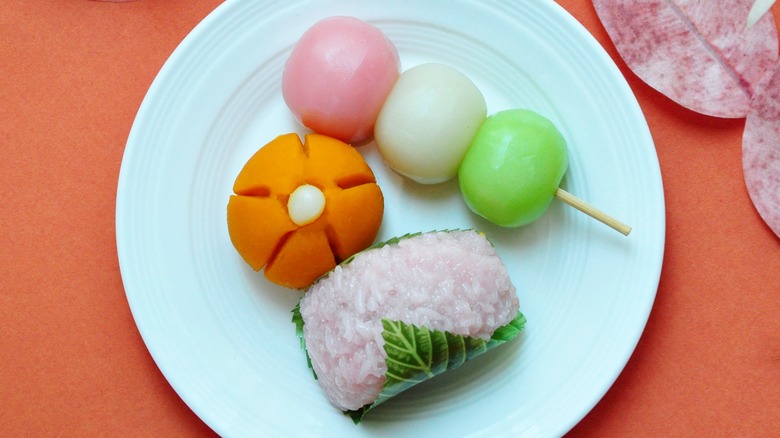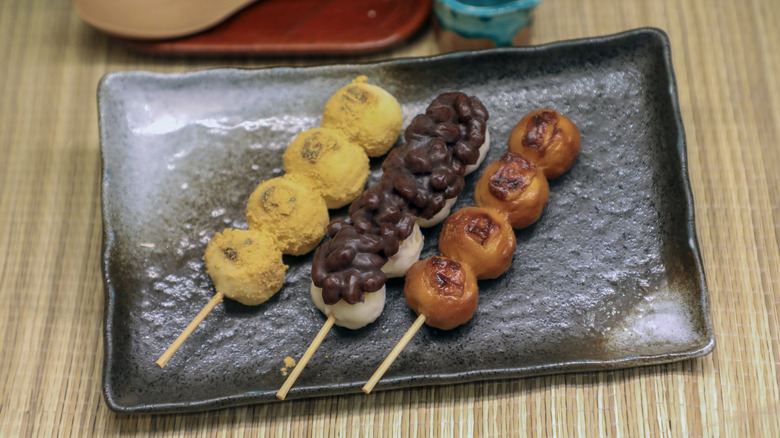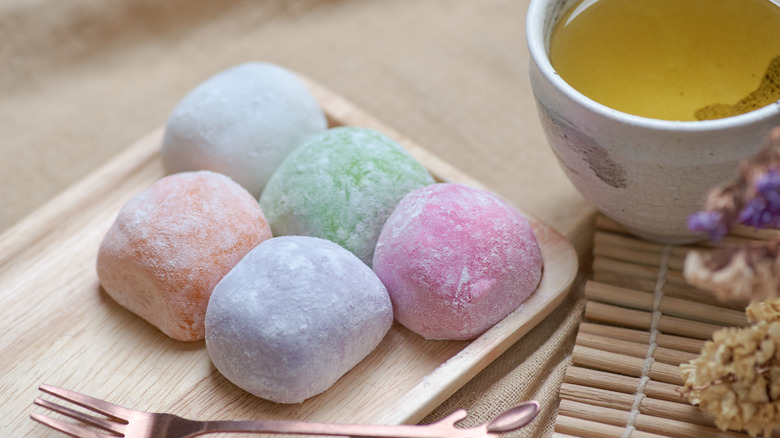The Ingredient That Sets Mochi And Dango Apart
Mochi and dango are both wonderfully chewy, rice-based Japanese treats that can be found in various delightful flavors and beautiful colors. Both fall under the category of wagashi, which are traditional, aesthetically pleasing Japanese sweets often served with green tea.
However, dango is not mochi, and mochi is not dango. Although dango is often mistakenly lumped together with mochi, it is prepared very differently and is characterized by a unique texture and serving style. Both mochi and dango are delicious in their own right, and it's important to know the distinction between these two treats so you can better appreciate both.
The key difference between mochi and dango is that, traditionally, mochi is made with cooked, pounded glutinous rice, while dango is a dumpling made with rice flour. As a result, dango is usually chewier, smaller, and denser than mochi. Additionally, dango is typically served as a sweet street food in sets of three to five balls on a skewer. In contrast, mochi comes in various shapes, sizes, and sweet and savory preparations.
What is dango?
Dango are small, spherical Japanese dumplings made from rice flour. The texture of dango is denser and chewier than mochi due to the use of rice flour instead of steamed, pounded rice. Dango are best eaten fresh and are typically served as a street snack. They're one of the most popular varieties of wagashi and are a staple at festivals and street fairs across Japan.
Dango are traditionally made by mixing rice flour with water, forming the dough into balls, and then steaming or boiling it. The resulting dumplings are usually served in sets of three to five on a handy skewer. Plain dango is relatively flavorless, but all kinds of delicious sauces and flavorings can be added.
Popular types of dango include mitarashi dango with a sweet soy glaze, red-bean paste smothered anko dango, and green tea-coated cha dango. Perhaps the most universally recognized variety is the hanami dango, the tri-colored green, white, and pink confection that inspired the dango emoji. Hanami dango is traditionally served in the spring, during cherry blossom season.
What is mochi?
Mochi is typically made from glutinous rice which is steamed and then pounded to achieve its signature chewy, sticky texture. Mochi pounding is traditionally performed by hand in a highly skilled and intensive process, although today most mochi pounding is done by machines.
The resulting mochi dough can be prepared in various ways, from sweet ice-cream stuffed mochi to savory deep-fried agemochi. Mochi is typically softer and bigger than dango, but still extremely chewy and delicious. Additionally, mochi is a much broader category than dango. It can come in a wide variety of shapes and sizes and is often found in packaged, dried, and frozen forms.
You might be thinking, what about those mochi donuts you're seeing everywhere? This is where things get a little complicated. Mochi donuts, mochi waffles, and other mochi-adjacent delights typically get their signature chewy, springy texture from rice flour or even tapioca flour. If you make mochi at home, you'll probably make it with rice or tapioca flour as well. The line between traditionally prepared mochi and dango is pretty clear, but modern preparations are harder to define and categorize. One thing is clear, however: Mochi and dango are both delightful and deserve to be appreciated as the unique dishes that they are.


